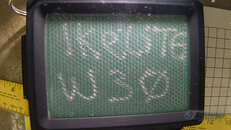I have not noticed any difference in the lens between the RX100 and RX100 M2. So in this article, whenever I refer to the M2, I am also referring to the original RX100.
There is a difference in the maximum focal length of the lenses in these cameras, but that will not be the subject of this article. This article will discuss the differences in these lenses for wide angle underwater use.
The RX100 M2 lenses at fully wide are 28mm equivalent focal length.
The RX100 M3 lens at full wide is a 24mm equivalent. This means that the RX100M3 field of view at full wide is a little bit wider than the RX100 and RX100M2 at fully wide.
While this may not make much difference to topside shooters, there is a very significant difference in these lenses for underwater photographers.
That difference is that the M2 when at fully wide, the lens is shorter than at full telephoto. So when a housing manufacturer designs the port for the M2 , it is designed just long enough to fit the camera with the lens at its longest; in this case, when it is zoomed fully telephoto.
The M3 when fully wide, the lens is at its longest. Therefore, when a housing manufacturer designs the port, it will be designed just long enough for the M3 to be zoomed fully wide.
Why this is good news to underwater photographers takes a little explaining.
To use a wet-mate wide angle conversion lens it is mounted on the port, and a very important factor in the resulting performance is the distance between the camera lens and the back lens of the wet-mate wide angle conversion lens.
If the camera lens is quite a distance away from the wet-mate wide angle conversion lens, one of the undersired results is that the camera lens will 'see' the back of the wet-mate wide angle lens. Other important factor is the the front of the camera lens does not optically line up with the back lens of the wet-mate wide angle conversion lens. For convenience we call the total results of this problem "vignetting."
If the distance between the camera lens and the wet-mate wide angle lens is very short, the camera lens will only see the lens part of the back lens of the wet-mate wide angle lens, and it will be better optically aligned with the wet-mate wide angle conversion lens which is exactly what is desired.
On the left an RX100 M2 at full wide. On the right, an RX100 M3 at full wide.
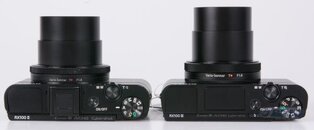
On the left an RX100 M2 zoomed to full telephoto. On the right, an RX100 M3 zoomed to full telephoto.
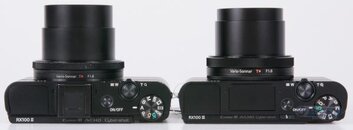
RX100 M2 fully wide. Please ignore the tenths of millimeters in these photos; I have never been trained as a machinist.
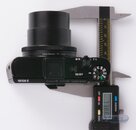
RX100 M2 fully zoomed
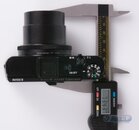
RX100M3 fully wide
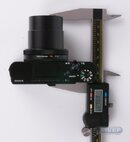
RX100 M3 fully zoomed
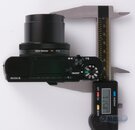
The distance between the front of the camera lens and the back of a close-up lens is not as important as the distance for wide angle lenses.
There is a difference in the maximum focal length of the lenses in these cameras, but that will not be the subject of this article. This article will discuss the differences in these lenses for wide angle underwater use.
The RX100 M2 lenses at fully wide are 28mm equivalent focal length.
The RX100 M3 lens at full wide is a 24mm equivalent. This means that the RX100M3 field of view at full wide is a little bit wider than the RX100 and RX100M2 at fully wide.
While this may not make much difference to topside shooters, there is a very significant difference in these lenses for underwater photographers.
That difference is that the M2 when at fully wide, the lens is shorter than at full telephoto. So when a housing manufacturer designs the port for the M2 , it is designed just long enough to fit the camera with the lens at its longest; in this case, when it is zoomed fully telephoto.
The M3 when fully wide, the lens is at its longest. Therefore, when a housing manufacturer designs the port, it will be designed just long enough for the M3 to be zoomed fully wide.
Why this is good news to underwater photographers takes a little explaining.
To use a wet-mate wide angle conversion lens it is mounted on the port, and a very important factor in the resulting performance is the distance between the camera lens and the back lens of the wet-mate wide angle conversion lens.
If the camera lens is quite a distance away from the wet-mate wide angle conversion lens, one of the undersired results is that the camera lens will 'see' the back of the wet-mate wide angle lens. Other important factor is the the front of the camera lens does not optically line up with the back lens of the wet-mate wide angle conversion lens. For convenience we call the total results of this problem "vignetting."
If the distance between the camera lens and the wet-mate wide angle lens is very short, the camera lens will only see the lens part of the back lens of the wet-mate wide angle lens, and it will be better optically aligned with the wet-mate wide angle conversion lens which is exactly what is desired.
On the left an RX100 M2 at full wide. On the right, an RX100 M3 at full wide.

On the left an RX100 M2 zoomed to full telephoto. On the right, an RX100 M3 zoomed to full telephoto.

RX100 M2 fully wide. Please ignore the tenths of millimeters in these photos; I have never been trained as a machinist.

RX100 M2 fully zoomed

RX100M3 fully wide

RX100 M3 fully zoomed

The distance between the front of the camera lens and the back of a close-up lens is not as important as the distance for wide angle lenses.
Last edited:




